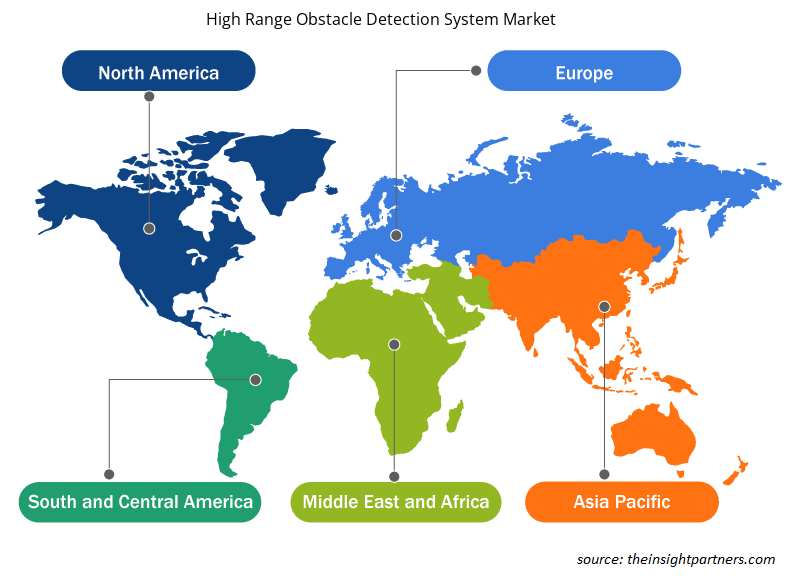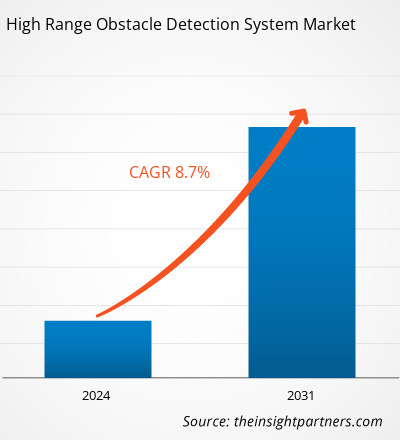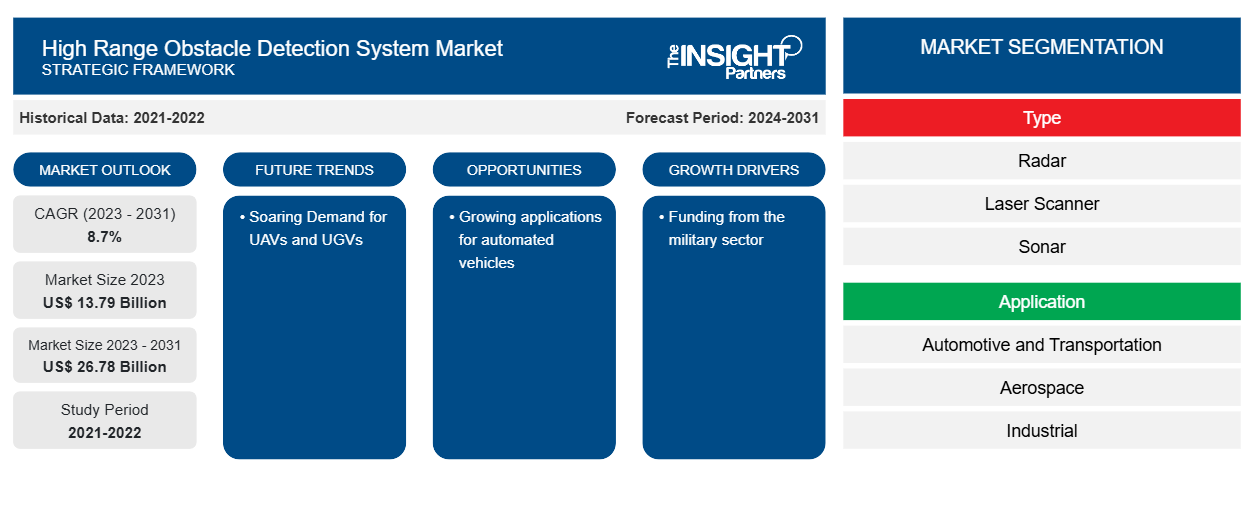Le marché des systèmes de détection d’obstacles à grande portée devrait atteindre 26,78 milliards de dollars américains d’ici 2031, contre 13,79 milliards de dollars américains en 2023. Le marché devrait enregistrer un TCAC de 8,7 % en 2023-2031. La demande croissante de systèmes de détection d’obstacles efficaces dans le secteur automobile et l’adoption de la technologie LiDAR dans diverses industries devraient rester essentielles aux tendances du marché des systèmes de détection d’obstacles à grande portée.
Analyse du marché des systèmes de détection d'obstacles à grande portée
Le marché mondial des systèmes de détection d'obstacles à grande portée devrait connaître une croissance rapide en raison de son application dans divers secteurs verticaux de l'industrie, notamment l'automobile, la robotique, l'aérospatiale et la défense. Certains des principaux facteurs à l'origine de la croissance du marché mondial des systèmes de détection d'obstacles à grande portée comprennent la demande croissante de véhicules autonomes et un besoin accru de détection de collision. Les avancées technologiques dans les capteurs et les composants associés devraient créer des opportunités importantes pour les acteurs du marché.
Aperçu du marché des systèmes de détection d'obstacles à grande portée
Une détection fiable des obstacles à grande portée est essentielle pour les plateformes rapides et critiques en matière de sécurité telles que les voitures autonomes afin de réagir aux dangers en temps réel. Un système de détection d'obstacles à grande portée détecte les obstacles tels que les arbres et les bâtiments à distance. Il fonctionne en utilisant des capteurs tels que des radars, des caméras et des lasers pour mesurer la hauteur et les objets dans l'environnement et avertir l'utilisateur lorsqu'un obstacle est détecté. Ces systèmes sont utilisés dans diverses applications, notamment la navigation des véhicules et des avions, la détection militaire, l'évitement des mines terrestres et autres.
Personnalisez ce rapport en fonction de vos besoins
Vous bénéficierez d'une personnalisation gratuite de n'importe quel rapport, y compris de certaines parties de ce rapport, d'une analyse au niveau des pays, d'un pack de données Excel, ainsi que de superbes offres et réductions pour les start-ups et les universités.
-
Obtenez les principales tendances clés du marché de ce rapport.Cet échantillon GRATUIT comprendra une analyse de données, allant des tendances du marché aux estimations et prévisions.
Moteurs et opportunités du marché des systèmes de détection d'obstacles à grande portée
Financement du secteur militaire pour favoriser le marché
Le système de détection d'obstacles à longue portée est un système de détection sophistiqué qui utilise à la fois les technologies radar et de vision pour détecter les obstacles et les dangers à longue distance. Il est utilisé dans les applications militaires, telles que les drones, les véhicules terrestres et les navires. Ce système utilise des capteurs avancés qui aident à détecter les obstacles en temps réel. Cette technologie avancée contribue à améliorer l'efficacité des drones, des véhicules de surface sans pilote ( USV ) et autres. Pour une telle utilisation de cette technologie dans le secteur militaire, les acteurs du marché sont financés par l'armée pour développer des solutions techniquement avancées. Par exemple, en décembre 2023, KEF Robotics a reçu un financement du ministère américain de la Défense pour développer une solution de détection d'obstacles activée par l'IA pour les drones captifs de l'armée américaine.
Des applications croissantes pour les véhicules automatisés
Le marché des véhicules automatisés et des systèmes de conduite autonome est en pleine croissance, car ils offrent un transport plus sûr et plus efficace. Les véhicules automatisés génèrent une demande pour le système de détection d'obstacles, ce qui favorise encore davantage la demande de systèmes de détection d'obstacles à grande portée pour obtenir une détection précise des obstacles. Avec l'adoption de cette solution, le véhicule détecte rapidement les obstacles et réagit en conséquence. Cette fonctionnalité améliore la sécurité des véhicules autonomes.
Analyse de segmentation du rapport sur le marché des systèmes de détection d'obstacles à grande portée
Les segments clés qui ont contribué à l’élaboration de l’analyse du marché des systèmes de détection d’obstacles à haute portée sont le type et l’application.
- En fonction du type, le marché est segmenté en radar, scanner laser , sonar et LiDAR. Le segment LiDAR devrait connaître le TCAC le plus élevé.
- En termes d'application, le marché est segmenté en applications automobiles et de transport, aérospatiales, industrielles, marines et autres. Le segment de l'automobile et des transports détenait une part de marché plus importante en 2023.
Analyse des parts de marché des systèmes de détection d'obstacles à grande portée par géographie
La portée géographique du rapport sur le marché des systèmes de détection d’obstacles à haute portée est principalement divisée en cinq régions : Amérique du Nord, Asie-Pacifique, Europe, Moyen-Orient et Afrique, et Amérique du Sud/Amérique du Sud et centrale.
La région Asie-Pacifique devrait connaître le taux de croissance annuel composé le plus élevé. Le marché de la détection d'obstacles à longue portée est en pleine croissance dans la région avec l'augmentation de l'utilisation des robots industriels. La large application de la détection d'obstacles à longue portée dans les véhicules autonomes et les drones favorise encore davantage la croissance de son marché.
Aperçu régional du marché des systèmes de détection d'obstacles à grande portée
Les tendances et facteurs régionaux influençant le marché des systèmes de détection d’obstacles à grande portée tout au long de la période de prévision ont été expliqués en détail par les analystes d’Insight Partners. Cette section traite également des segments et de la géographie du marché des systèmes de détection d’obstacles à grande portée en Amérique du Nord, en Europe, en Asie-Pacifique, au Moyen-Orient et en Afrique, ainsi qu’en Amérique du Sud et en Amérique centrale.

- Obtenez les données régionales spécifiques pour le marché des systèmes de détection d'obstacles à grande portée
Portée du rapport sur le marché des systèmes de détection d'obstacles à grande portée
| Attribut de rapport | Détails |
|---|---|
| Taille du marché en 2023 | 13,79 milliards de dollars américains |
| Taille du marché d'ici 2031 | 26,78 milliards de dollars américains |
| Taux de croissance annuel composé mondial (2023-2031) | 8,7% |
| Données historiques | 2021-2022 |
| Période de prévision | 2024-2031 |
| Segments couverts |
Par type
|
| Régions et pays couverts |
Amérique du Nord
|
| Leaders du marché et profils d'entreprises clés |
|
Densité des acteurs du marché : comprendre son impact sur la dynamique des entreprises
Le marché des systèmes de détection d'obstacles à grande portée connaît une croissance rapide, tirée par la demande croissante des utilisateurs finaux en raison de facteurs tels que l'évolution des préférences des consommateurs, les avancées technologiques et une plus grande sensibilisation aux avantages du produit. À mesure que la demande augmente, les entreprises élargissent leurs offres, innovent pour répondre aux besoins des consommateurs et capitalisent sur les tendances émergentes, ce qui alimente davantage la croissance du marché.
La densité des acteurs du marché fait référence à la répartition des entreprises ou des sociétés opérant sur un marché ou un secteur particulier. Elle indique le nombre de concurrents (acteurs du marché) présents sur un marché donné par rapport à sa taille ou à sa valeur marchande totale.
Les principales entreprises opérant sur le marché des systèmes de détection d'obstacles à grande portée sont :
- BAE Systems plc
- Blickfeld GmbH
- Collins Aérospatiale
- Honeywell International Inc.
- ifm electronic gmbh
- LIVOX
Avis de non-responsabilité : les sociétés répertoriées ci-dessus ne sont pas classées dans un ordre particulier.

- Obtenez un aperçu des principaux acteurs du marché des systèmes de détection d'obstacles à grande portée
Actualités et développements récents du marché des systèmes de détection d'obstacles à grande portée
Le marché des systèmes de détection d'obstacles à grande portée
est évalué en collectant des données qualitatives et quantitatives après des recherches primaires et secondaires, qui comprennent des publications d'entreprise importantes, des données d'association et des bases de données. Voici une liste des évolutions du marché :
- En mai 2023, le Bosch Engineering Center de Cluj a annoncé l'installation d'un système d'avertissement de collision développé par Bosch, appelé Tram Forward Collision Warning (TFCW), sur un tramway faisant partie de la flotte de la société de transport public de Cluj-Napoca (CTP). Le système assiste les conducteurs de tramway dans les situations critiques en émettant des avertissements sonores et visuels, améliorant ainsi la sécurité des conducteurs de tramway, des passagers et des autres usagers de la route. Le système d'avertissement de collision de tramway aide les conducteurs dans les situations critiques en les avertissant à temps des obstacles sur les voies, en particulier dans des conditions de trafic encombré ou de visibilité réduite. Cela permet aux conducteurs d'éviter les accidents ou de réduire considérablement les dommages. (Communiqué de presse, 2023)
Rapport sur le marché des systèmes de détection d'obstacles à grande portée et livrables
Le rapport « Taille et prévisions du marché des systèmes de détection d’obstacles à grande portée (2023-2031) » fournit une analyse détaillée du marché couvrant les domaines ci-dessous :
- Taille du marché et prévisions aux niveaux mondial, régional et national pour tous les segments de marché clés couverts par le périmètre
- Dynamique du marché, comme les facteurs moteurs, les contraintes et les opportunités clés
- Principales tendances futures
- Analyse détaillée des cinq forces de PEST/Porter et SWOT
- Analyse du marché mondial et régional couvrant les principales tendances du marché, les principaux acteurs, les réglementations et les développements récents du marché
- Analyse du paysage industriel et de la concurrence couvrant la concentration du marché, l'analyse de la carte thermique, les principaux acteurs et les développements récents
- Profils d'entreprise détaillés
- Analyse historique (2 ans), année de base, prévision (7 ans) avec TCAC
- Analyse PEST et SWOT
- Taille du marché Valeur / Volume - Mondial, Régional, Pays
- Industrie et paysage concurrentiel
- Ensemble de données Excel
Rapports récents
Témoignages
Raison d'acheter
- Prise de décision éclairée
- Compréhension de la dynamique du marché
- Analyse concurrentielle
- Connaissances clients
- Prévisions de marché
- Atténuation des risques
- Planification stratégique
- Justification des investissements
- Identification des marchés émergents
- Amélioration des stratégies marketing
- Amélioration de l'efficacité opérationnelle
- Alignement sur les tendances réglementaires























 Obtenez un échantillon gratuit pour - Marché des systèmes de détection d'obstacles à grande portée
Obtenez un échantillon gratuit pour - Marché des systèmes de détection d'obstacles à grande portée